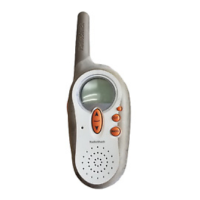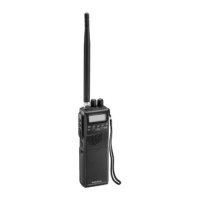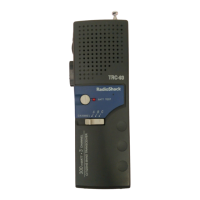Do you have a question about the Radio Shack 21-1905 and is the answer not in the manual?
Important warnings and recommendations for safely installing batteries, including mixing types or using non-rechargeable ones.
How to interpret the battery icon's segments and when to replace batteries.
Warnings regarding charging non-rechargeable batteries and using correct power sources for charging.
Step-by-step instructions on how to charge batteries using the 6V DC jack and an adapter.
Instructions for placing batteries and the radio into the slow-charger for recharging.
How to turn the radio on and off and adjust the volume using the rotary switch.
Instructions on how to transmit a voice message using the PTT button and power saving limits.
Method for manually selecting the desired channel using UP or DOWN keys.
How to scan channels and quiet codes automatically to find active users.
Procedure to lock and unlock the keypad, and its implications for other functions.
Enabling and adjusting the Voice Operated Transmission (VOX) feature for hands-free communication.
Configuring the Automatic Power Off (APO) feature to conserve battery life.
Selecting transmit power levels (0.5W or 2W) for GMRS channels.
Connecting and using an optional headset for hands-free operation.
How Caller ID works, including sending, receiving, and the temporary private code setting.
Configuring the receiver's ID number for targeted calls or group calls.
How call melodies are generated based on Call ID or Sender ID numbers.
Instructions on how to attach and detach the swivel belt clip.
Steps to attach an optional wrist strap to the radio for secure carrying.
Guidelines for keeping the radio dry, clean, and in good working condition.
Warnings against modifying the radio and advice on identifying and reducing interference.
Information on FCC regulations, licensing, and contact details for obtaining forms and assistance.
Precautions for maintaining compliance with RF exposure limits, including antenna distance and body worn usage.
Technical details such as frequency range, output power, power supply, and dimensions.
Important warnings and recommendations for safely installing batteries, including mixing types or using non-rechargeable ones.
How to interpret the battery icon's segments and when to replace batteries.
Warnings regarding charging non-rechargeable batteries and using correct power sources for charging.
Step-by-step instructions on how to charge batteries using the 6V DC jack and an adapter.
Instructions for placing batteries and the radio into the slow-charger for recharging.
How to turn the radio on and off and adjust the volume using the rotary switch.
Instructions on how to transmit a voice message using the PTT button and power saving limits.
Method for manually selecting the desired channel using UP or DOWN keys.
How to scan channels and quiet codes automatically to find active users.
Procedure to lock and unlock the keypad, and its implications for other functions.
Enabling and adjusting the Voice Operated Transmission (VOX) feature for hands-free communication.
Configuring the Automatic Power Off (APO) feature to conserve battery life.
Selecting transmit power levels (0.5W or 2W) for GMRS channels.
Connecting and using an optional headset for hands-free operation.
How Caller ID works, including sending, receiving, and the temporary private code setting.
Configuring the receiver's ID number for targeted calls or group calls.
How call melodies are generated based on Call ID or Sender ID numbers.
Instructions on how to attach and detach the swivel belt clip.
Steps to attach an optional wrist strap to the radio for secure carrying.
Guidelines for keeping the radio dry, clean, and in good working condition.
Warnings against modifying the radio and advice on identifying and reducing interference.
Information on FCC regulations, licensing, and contact details for obtaining forms and assistance.
Precautions for maintaining compliance with RF exposure limits, including antenna distance and body worn usage.
Technical details such as frequency range, output power, power supply, and dimensions.
| frequency range | 462.5000 – 467.7125 MHz |
|---|---|
| channels | 22 |
| RF output power (low) | 400-500 mW ERP |
|---|---|
| RF output power (high) | 1.8-2 W ERP |
| power supply | 6.0 V DC (4 x AA Alkaline) |
| battery life | about 16 hours (alkaline batteries) |
|---|---|
| operating temperature | -4 to 122 ºF (-20 to 50 ºC) |
| dimension (HWD) | 102 x 57 x 35 mm |
| weight | 100 gm |
|---|












